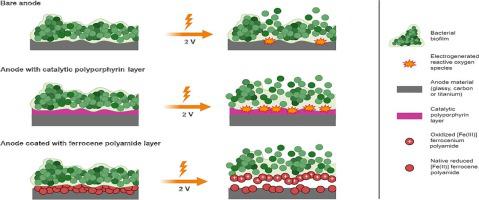当前位置:
X-MOL 学术
›
Eur. Polym. J.
›
论文详情
Our official English website, www.x-mol.net, welcomes your feedback! (Note: you will need to create a separate account there.)
Improved electro-destruction of bacterial biofilms by coating conductive surfaces with polymers
European Polymer Journal ( IF 6 ) Pub Date : 2024-03-08 , DOI: 10.1016/j.eurpolymj.2024.112910 Stephane Hoang , Hanna Zhukouskaya , Iryna Ivanko , Jan Svoboda , Michaela Hympánová , Jan Marek , Ondřej Soukup , Miroslav Šlouf , Jan Kotek , Eric Doris , Edmond Gravel , Elena Tomšík , Martin Hrubý
European Polymer Journal ( IF 6 ) Pub Date : 2024-03-08 , DOI: 10.1016/j.eurpolymj.2024.112910 Stephane Hoang , Hanna Zhukouskaya , Iryna Ivanko , Jan Svoboda , Michaela Hympánová , Jan Marek , Ondřej Soukup , Miroslav Šlouf , Jan Kotek , Eric Doris , Edmond Gravel , Elena Tomšík , Martin Hrubý

|
The formation of biofilm involves cell aggregation and adherence, enveloped by a self-produced extracellular matrix. In the medical domain, biofilm-associated infections pose significant challenges, especially concerning implants. This investigation focuses on enhancing electromediated bacterial biofilm eradication through polymer coatings on the anode. These coatings catalyze reactive oxygen species (ROS) generation or convert hydrophobic coatings to bactericidal hydrophilic polycations, detaching the biofilms that are predominantly polyanionic. The first approach employs a metallized polytetrathienylporphyrin layer with ROS catalytic capability, while the second involves an insoluble hydrophobic polyamide, which, upon oxidation, transforms into a bactericidal hydrolytically degradable polycation. Both approaches show promising efficacy in augmenting electromediated biofilm destruction.
中文翻译:

通过用聚合物涂覆导电表面来改善细菌生物膜的电破坏
生物膜的形成涉及细胞聚集和粘附,被自身产生的细胞外基质包裹。在医疗领域,生物膜相关感染带来了重大挑战,特别是对于植入物而言。这项研究的重点是通过阳极上的聚合物涂层增强电介导的细菌生物膜根除。这些涂层催化活性氧(ROS)的产生或将疏水性涂层转化为杀菌性亲水性聚阳离子,从而分离主要为聚阴离子的生物膜。第一种方法采用具有 ROS 催化能力的金属化聚四噻吩基卟啉层,而第二种方法涉及不溶性疏水性聚酰胺,该聚酰胺在氧化后转化为杀菌、可水解降解的聚阳离子。这两种方法在增强电介导的生物膜破坏方面都显示出有希望的功效。
更新日期:2024-03-08
中文翻译:

通过用聚合物涂覆导电表面来改善细菌生物膜的电破坏
生物膜的形成涉及细胞聚集和粘附,被自身产生的细胞外基质包裹。在医疗领域,生物膜相关感染带来了重大挑战,特别是对于植入物而言。这项研究的重点是通过阳极上的聚合物涂层增强电介导的细菌生物膜根除。这些涂层催化活性氧(ROS)的产生或将疏水性涂层转化为杀菌性亲水性聚阳离子,从而分离主要为聚阴离子的生物膜。第一种方法采用具有 ROS 催化能力的金属化聚四噻吩基卟啉层,而第二种方法涉及不溶性疏水性聚酰胺,该聚酰胺在氧化后转化为杀菌、可水解降解的聚阳离子。这两种方法在增强电介导的生物膜破坏方面都显示出有希望的功效。



























 京公网安备 11010802027423号
京公网安备 11010802027423号